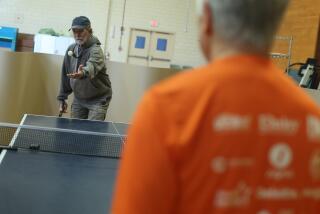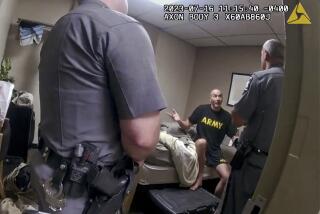Treating traumatic brain injuries
Larry Ewing’s life changed last year on a construction site in Victorville; Larry Carr’s changed in 2004 on a road in Iraq. Unlikely brothers in arms, both men now share the same invisible wound -- traumatic brain injury.
They tire easily, forget often and lose their balance and concentration without warning. They struggle to make peace with personality changes that have made them barely recognizable to loved ones.
And they -- like millions of brain-injured civilians, and hundreds of thousands of troops whose brains have been jolted by blasts in Iraq and Afghanistan -- find that their best hope for better diagnosis and care comes from military medicine.
Carr, 39, dispatched to Iraq as a sergeant in the Army National Guard, was a medic with the 1st Infantry Division when a roadside bomb exploded alongside the Humvee in which he was riding. The concentrated power of six 155-millimeter artillery shells buried in a mound of debris blew into the vehicle’s open side window. It knocked him over and out for less than a half-minute, but he quickly rallied. Trained as a medic, Carr calmly talked the Humvee’s gunner through the steps of bandaging his head, which was bleeding from shrapnel wounds.
Carr underwent surgery to remove a rock and shrapnel from his head, but his skull hadn’t been fractured. On standard CT scans done at Balad Air Base in Iraq, his brain appeared unhurt.
But upon returning home, the signs that all was not well mounted. Carr was plagued by debilitating daily headaches and regularly “yelled like a drill sergeant” at his wife and kids with no provocation. He slept for much of the day and forgot to eat for days at a time. His efforts to recall his childhood drew a blank. He was forgetful, distracted.
One day, having been discharged from the Army as “unfit for military service” and presumed to be suffering from post-traumatic stress disorder, Carr sat down at his kitchen table to help his youngest with her fourth-grade math homework. He had graduated from his medic training at the top of his class; this sort of thing had come easily. But Carr could make sense of none of it, and when he tried, his bewilderment only grew.
“I always thought of myself as highly intelligent before. And now I’m failing fourth-grade math,” Carr says. “I feel like a complete idiot. That’s one of the things that’s the hardest: I know I used to be smart enough to do this. And now I’m not.”
Ewing, 60, a supervising equipment officer for the city of Victorville, was helping to unload a tractor-trailer when the truck’s contents shifted. The rolling canisters knocked him backward. Ewing fell, slamming his head into the inside wall of the truck. But he chatted with co-workers after the accident, took a call on his cellphone from his wife, Pat, and was out of the hospital in four days.
CT scans and magnetic resonance imaging of Ewing’s brain showed no abnormalities, nor did brain-wave monitoring on an electroencephalograph.
But today, Ewing too has lost brainpower and independence.
Because his central vision has shifted sideways and his peripheral vision has dimmed, he misjudges distances and walks into things. He is easily disoriented and becomes dizzy from sudden movements and changes of orientation. New information seldom settles in for long. He forgets to turn off the stove, or to check for cars before stepping into the street. His reading and writing skills have fallen back to roughly sixth-grade levels, Pat Ewing says.
But worst of all, the self-reliance and social confidence that made her husband someone who “could handle anything that was thrown at him” is gone.
Larry Ewing was once the kind of guy, Pat says, who would stand in a line at the bank for 20 minutes and come out knowing the life story of the person who stood behind him. Now, she says, he will not initiate conversations, and answers questions with a few words in a barely audible monotone. He shuts off chats abruptly or rambles on far too long with friends and loved ones. Faced with chaos, choices or noise, he becomes confused, then withdraws. Parties are a trial; a walk down the supermarket’s cereal aisle is unthinkable.
“He was a superintendent, he kept track of 60 people,” Pat Ewing says. “He told the doctors recently, ‘I can’t even keep track of myself now.’ He sometimes says he’s stupid, I keep correcting him: He has a brain injury.”
Both men had believed recovery was right around the corner. Their doctors greeted their persistent complaints with soothing reassurances that nothing was fundamentally wrong. Friends told them they looked great and asked when they were going to get a job or go back to work.
Even their wives wondered what kept their outwardly healed husbands from getting on with life. “For a long time she knew something was wrong but didn’t know what it was,” Larry Carr says of his wife, Paula. “She’s realizing it more and more: It’s something that she can’t see,” he says.
One day, Carr’s psychiatrist, a former Army reservist who had spent time in Afghanistan, told him of a new study emerging from the military’s increasing research into the detection, prevention and treatment of brain injury. Many of the symptoms of PTSD, for which Carr was being treated, mimic the symptoms of traumatic brain injury, said Carr’s physician, Dr. Bruce Capehart. Let’s get you tested, Capehart proposed.
When the results of a lengthy battery of cognitive tests made it clear that Carr’s brain had sustained serious injury, Carr felt a powerful sense of relief. “I was like, ‘Well, that explains stuff a little better,’ ” he says.
Though not a soldier, Ewing similarly benefited from military research on new diagnostic imaging technologies. An alphabet soup’s worth of tests -- CT scans, MRIs, EEGs -- all had failed to show brain abnormalities, but an imaging technique improved and promoted to wider use by the military finally exposed the cause of Ewing’s cognitive troubles: inert and sluggish activity of cells throughout multiple areas of his brain.
“He was very pleased with results showing some damage,” Pat Ewing says of her husband’s reaction to the magnetic resonance spectroscopy. “I know there’s something wrong with me,” Larry Ewing adds, “But no tests showed that . . . the doctors just don’t see it.”
The long-term prognosis is uncertain for both men. But with proper diagnosis of their conditions, they have begun long-term rehabilitative treatment. Military research has begun to explore which of many treatments can best help brain injury victims regain at least some lost skills.
The men and their families struggle amid very different prospects of help, however. Long-term care is something in which Carr, under the Veteran Administration’s auspices, has substantial certainty. Ewing, hurt in a workplace accident, will lose his workers’ compensation benefits in a few months. After that, it’s not clear how he will manage.
Ewing is pleased with the growing awareness of brain injury, brought about by the armed forces’ considerable research and rehabilitation dollars. He also hopes that more of those benefits -- and the sympathy -- that brain-injured veterans are getting will begin to flow to civilians fighting the same battles in communities across the country.
“I feel for them,” says Ewing, a Vietnam veteran. “They deserve everything they can get and more. But so do I.”







